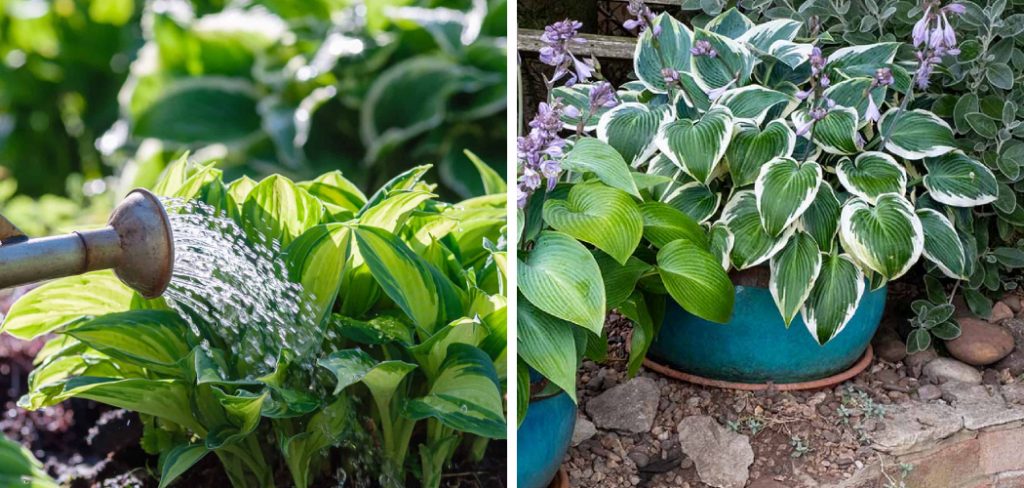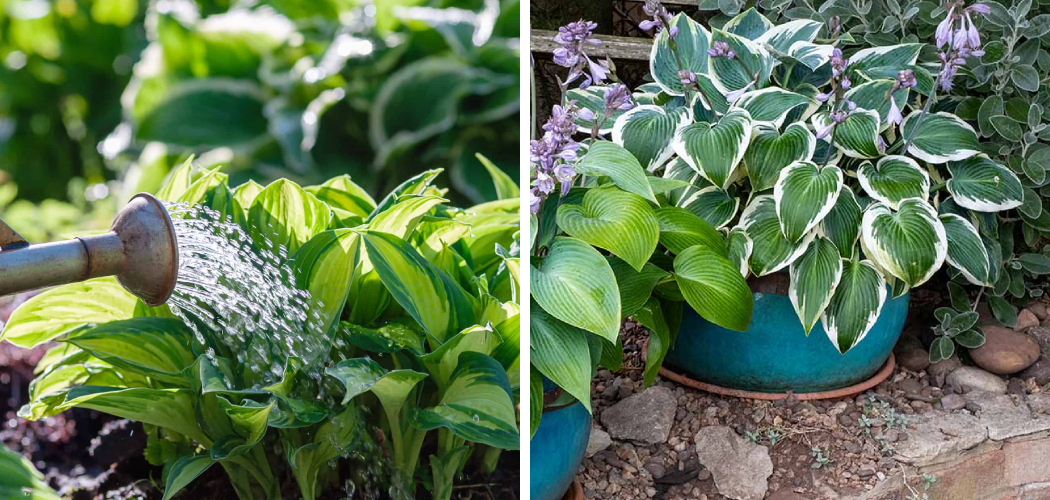To water hostas, provide them with consistent moisture by watering deeply once a week, ensuring the soil is evenly saturated. Hostas require regular watering to thrive and maintain healthy foliage.
Consistent moisture is key, so water deeply once a week, making sure the soil is evenly saturated. Providing a good soaking encourages strong root development. It’s important to avoid overwatering, as hostas also need well-draining soil to prevent root rot.
Additionally, be mindful of weather conditions and adjust watering frequency accordingly. By following these watering tips, you can help your hostas flourish and add beauty to your garden.

Understanding Hostas And Their Watering Needs
Understanding the watering needs of hostas is crucial for their overall health and growth. Different hosta varieties have varying moisture requirements. It is important to water them properly to ensure their well-being. Over-watering can lead to root rot, while under-watering can cause stunted growth.
To determine the right amount of water, check the soil moisture using your finger. If the top inch of soil feels dry, it’s time to water. Water deeply and thoroughly, allowing the water to penetrate the root zone. Avoid overhead watering as it can promote diseases.
Mulching around the base of the plants can help retain moisture and regulate soil temperature. Regularly monitor the weather conditions and adjust watering accordingly. Proper watering practices will help your hostas thrive and provide a beautiful display in your garden.
Factors To Consider Before Watering Hostas
Factors like soil moisture, weather conditions, and watering schedules play a vital role in properly watering hostas. Assessing the moisture levels in the soil is crucial to determine whether watering is necessary. Depending on the weather, hostas may require more or less water.
Understanding their water demands based on the climate is essential. Additionally, establishing an ideal watering schedule is important to avoid over or underwatering the plants. By keeping these factors in mind, you can ensure that your hostas receive the appropriate amount of water to thrive.
How to Water Hostas: Step by Step Guide
Practices For Watering Hostas
Watering hostas requires following best practices to ensure their health and vitality. Using the proper watering techniques is crucial. Hostas need the right amount of water to thrive, so it’s important to provide adequate hydration. Avoid making common mistakes when watering hostas, such as overwatering or underwatering.
These mistakes can lead to root rot or dehydration. To water hostas effectively, consider factors like soil moisture, weather conditions, and the plant’s stage of growth. It’s essential to water deeply to encourage deep root growth. Avoid shallow watering, as it can cause hostas to develop shallow root systems.
By following these guidelines, you can maintain healthy and beautiful hostas in your garden.
Watering Techniques For Hostas
Watering hostas is an essential task to promote their healthy growth. Hand watering can be done using a watering can or hose, allowing you to control the amount of water applied. However, using irrigation systems can be more convenient, especially for large gardens.
Properly applying water to the root zone is crucial to ensure that hostas receive adequate hydration. The root zone is where the majority of the roots are located, so direct watering in this area is essential. Utilizing mulch around hostas can help retain soil moisture, reducing the need for frequent watering.
Mulch acts as a barrier, preventing evaporation and maintaining a consistent moisture level in the soil. By following these watering techniques, you can keep your hostas healthy and thriving.
Determining The Ideal Watering Amount For Hostas
Hostas are beautiful plants that require the right amount of water at different stages of growth. To determine the ideal watering amount, it is essential to understand their water requirements. Soil conditions play a crucial role in tailoring water quantities for hostas.
It’s important to avoid overwatering as it can have adverse effects on these plants. Overwatering can lead to root rot and other issues. To ensure the health of your hostas, monitor the moisture level of the soil and water accordingly.
A good practice is to water deeply and less frequently rather than surface watering. By providing the proper amount of water and maintaining optimal soil conditions, you can keep your hostas thriving and vibrant throughout the growing season.
Common Mistakes To Avoid When Watering Hostas
Watering hostas may seem simple, but it’s crucial to avoid common mistakes. Overwatering can lead to root rot, putting your plants at risk. On the other hand, underwatering has a negative impact on hosta health. It’s essential to find the right balance.
Timing is also important; avoid watering during inappropriate times of the day. Providing sufficient water without overdoing it is the key to maintaining healthy hostas. By following these guidelines, you can ensure the optimal growth and longevity of your hosta plants.
Signs Of Proper And Improper Hosta Watering
Proper watering is crucial for the health and vitality of your hostas. To ensure you’re watering them correctly, it’s important to recognize the signs indicating sufficient hydration. The first indicator is observing healthy, vibrant leaves that are not wilting or drooping.
Another positive sign is the presence of new growth and buds, showcasing the plant’s ability to thrive. On the other hand, overwatering can cause leaves to yellow or wilt, accompanied by a soft, mushy texture. Underwatering, on the contrary, results in dry, brown and crispy leaves.
It’s essential to troubleshoot any water-related issues promptly. Consider adjusting the amount of water you give, ensuring proper drainage in the soil, and providing shade during hot weather to prevent excessive evaporation. By carefully monitoring signs and making necessary adjustments, you can maintain the optimal watering routine for your hostas’ well-being.
Advanced Techniques For Watering Hostas
Hostas have specific watering needs, especially when they are grown in pots. During extreme weather conditions, it is crucial to provide adequate water to prevent any damage. To ensure sustainability, rainwater harvesting can be implemented as an advanced technique for watering hostas.
This practice not only conserves water but also reduces the reliance on external water sources. By collecting rainwater, you can meet the moisture requirements of your potted hostas while promoting environmental conservation. Proper watering is essential for the health and growth of hostas, so it is important to pay attention to their specific needs.
Mastering Hosta Watering For Vibrant And Thriving Plants
Properly watering hostas is crucial to maintaining vibrant and thriving plants. To ensure their health, follow these essential guidelines. First, water hostas deeply, ensuring the water reaches the roots. This encourages strong growth and prevents the plant from becoming stressed.
Second, water hostas consistently, aiming for a regular schedule to provide consistent moisture. Third, avoid overwatering, as excessive moisture can lead to root rot. Fourth, make use of mulch to retain soil moisture and prevent evaporation. Fifth, water hostas early in the morning or late in the evening to minimize evaporation and allow the leaves to dry quickly, reducing the risk of disease.
Lastly, water hostas at the soil level rather than from overhead to prevent damage to the leaves. By following these guidelines, you can maintain healthy and thriving hostas.
Frequently Asked Questions On How To Water Hostas
How Do You Keep Hostas Happy?
To keep hostas happy, follow these tips: 1. Ensure they get enough shade to protect them from direct sunlight. 2. Keep the soil consistently moist, but not waterlogged. 3. Provide them with nutrient-rich soil and organic mulch. 4. Regularly remove any damaged or yellowing leaves to maintain their health.
How Do You Encourage Hostas To Grow?
Encourage hostas to grow by providing well-drained soil, partial shade, regular watering, and occasional fertilization.
What Does Epsom Salt Do For Hostas?
Epsom salt enhances the growth and health of hostas by supplying magnesium and improving nutrient uptake.
How Do You Keep Hostas From Turning Brown?
To prevent brown leaves on hostas: Provide enough water, maintain proper drainage, protect from direct sunlight, and prune damaged foliage.
Conclusion
Good watering practices are essential for the health and vitality of your hostas. By following a few simple steps, you can ensure that your hostas receive the right amount of water to thrive. Start by watering deeply and infrequently, allowing the water to penetrate the soil and reach the roots.
Avoid overwatering, as this can lead to root rot and other issues. Instead, monitor the moisture level of the soil and water only when it feels dry to the touch. Mulching around your hostas can also help retain moisture and prevent weed growth.
Finally, consider using a soaker hose or drip irrigation system to deliver water directly to the roots. By implementing these watering techniques, you can enjoy healthy and vibrant hostas in your garden for years to come.

